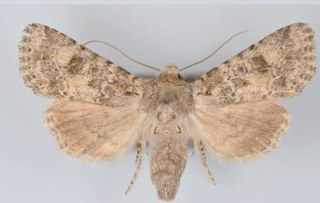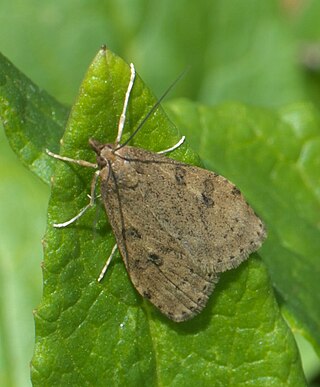
Apamea crenata, known as the clouded-bordered brindle, is a moth in the family Noctuidae. It is distributed throughout the Palearctic realm. In the North it crosses the Arctic Circle, in the Mediterranean it is found only in cool locations and mountains avoiding very hot areas. In the Alps, it rises to an altitude of about 2000 metres.
Dichozoma is a monotypic moth genus of the family Crambidae erected by Eugene G. Munroe in 1961. Its only species, Dichozoma parvipicta, was first described by William Barnes and James Halliday McDunnough in 1918. It is found in North America, where it has been recorded from Arizona, California, Utah and Texas.

Catocala nymphagoga, the oak yellow underwing, is a moth of the family Erebidae. It is found in Southern Europe, from Bulgaria up to the Iberian Peninsula and sometimes further north as a migrant. It is also found in North Africa and Asia Minor.

Aseptis catalina is a moth of the family Noctuidae first described by John Bernhardt Smith in 1899. It is found in the deserts of Arizona, California and Baja California in Mexico.

Properigea albimacula is a small to medium-sized moth in the family Noctuidae first described by William Barnes and James Halliday McDunnough in 1912. It is found in the western US on the slopes of Cascades north of Oregon and almost throughout California. The wingspan is about 15 mm. Adults fly during the summer and are most common during July. This species is nocturnal and comes to lights.

Protorthodes antennata is a moth in the family Noctuidae first described by William Barnes and James Halliday McDunnough in 1912. It has a small distribution in North America, extending from central Arizona to northernmost Mexico.
Scoparia rigidalis is a moth in the family Crambidae. It was described by William Barnes and James Halliday McDunnough in 1912. It is found in North America, where it has been recorded from Arizona.
Gyros atripennalis is a moth in the family Crambidae. It was described by William Barnes and James Halliday McDunnough in 1914. It is found in North America, where it has been recorded in California.
Noctueliopsis virula is a moth in the family Crambidae. It was described by William Barnes and James Halliday McDunnough in 1918. It is found in North America, where it has been recorded from Arizona, California and Nevada.
Blepharomastix pseudoranalis is a moth in the family Crambidae first described by William Barnes and James Halliday McDunnough in 1914. It is found in North America, where it has been recorded from Arizona.
Choristostigma disputalis is a moth in the family Crambidae. It was described by William Barnes and James Halliday McDunnough in 1917. It is found in North America, where it has been recorded from Alberta, Arizona, British Columbia, California and Oregon.
Choristostigma leucosalis is a moth in the family Crambidae. It was described by William Barnes and James Halliday McDunnough in 1914. It is found in Mexico and the southern United States, where it has been recorded from southern California, Arizona and Texas.
Choristostigma zephyralis is a moth in the family Crambidae first described by William Barnes and James Halliday McDunnough in 1914. It is found in North America, where it has been recorded from California.
Mimudea punctiferalis is a moth in the family Crambidae. It was described by South in 1901. It is found in China.
Udea binoculalis is a moth in the family Crambidae. It was described by George Hampson in 1904. It is found on the Bahamas.
Udea rusticalis is a moth in the family Crambidae. It was described by William Barnes and James Halliday McDunnough in 1914. It is found in North America, where it has been recorded from Arizona.

Udea torvalis is a moth in the Crambidae family. It was described by Möschler in 1864. It is found in North America, where it has been recorded from Labrador, Nunavut, the Northwest Territory and Yukon. It has also been recorded from Greenland and Russia.

Udea turmalis is a moth in the family Crambidae. It was described by Augustus Radcliffe Grote in 1881. It is found in North America, where it has been recorded from Alberta, Arizona, British Columbia, California, Colorado, Idaho, Manitoba, Montana, Nevada, New Mexico, Utah and Washington.
Drasteria pulchra is a moth of the family Erebidae first described by William Barnes and James Halliday McDunnough in 1918. It is found in North America, where it has been recorded from California.

Aseptis serrula is a moth of the family Noctuidae first described by William Barnes and James Halliday McDunnough in 1918. It is found in the lower mountain-desert transition zone and in high desert such as the Mojave, Colorado, and Sonora deserts of south-eastern California, Nevada, Arizona and Baja California.







